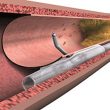Peripheral artery disease (PAD) is no longer a systemic manifestation of atherosclerosis. In fact, 2 in 3 people with PAD have concomitant heart disease, and 1 in 3 people has concomitant PAD. To understand the real dimension of this problem, we should know that PAD patients have 60% more risk of acute myocardial infarction<a href="https://solaci.org/en/2017/08/22/risk-of-thrombosis-and-bleeding-with-peripheral-artery-disease-and-concomitants/" title="Read more" >...</a>
See All ProEducar “José Gabay” Course (Eighth Edition) Presentations
We are deeply thankful to all interventional physicians who, motivated by their great scientific and educational vocation, presented their works at the “José Gabay” Course and actively collaborated in training and providing updated concepts for the next generations of interventional cardiologists. Read and/or download the presentations below: Module I: Fundamentals and Basic Elements. Álvarez, José.<a href="https://solaci.org/en/2017/08/22/see-all-proeducar-jose-gabay-course-eighth-edition-presentations/" title="Read more" >...</a>
Common Femoral PCI Becomes a Valid Alternative
Gentileza del Dr. Carlos Fava. The common femoral artery has always been treated with surgery. Thanks to the development of new generation stents and the advancement of percutaneous intervention, common femoral lesions are currently being treated with PCI. However, data on the safety of PCI vs. surgery, remain unavailable. The TECCO is multicenter study, randomized<a href="https://solaci.org/en/2017/08/17/common-femoral-pci-becomes-a-valid-alternative/" title="Read more" >...</a>
Different Techniques for the Improvement of Outcomes in Intermittent Claudication
Peripheral vascular diseases affect over 20% of the population and can affect up to 30% of people with cardiovascular risk factors. The most important treatment points include modification of risk factors, exercise, optimal medical treatment, and timely revascularization. Given its lower risk of peri-procedural complications (when compared to surgery), endovascular therapy is generally the first<a href="https://solaci.org/en/2017/08/14/different-techniques-for-the-improvement-of-outcomes-in-intermittent-claudication/" title="Read more" >...</a>
Valve Deterioration after TAVI Is Rare and Should Not Prevent Advancement to Younger Populations
Durability ─or better yet, lack of deterioration─ is still a matter of debate when considering transcatheter aortic valve intervention (TAVI), especially now that it is being explored as a real alternative for younger patients. A recently published meta-analysis offers more evidence and suggests TAVI deterioration is mostly rare within the first 5 years. According to<a href="https://solaci.org/en/2017/08/14/valve-deterioration-after-tavi-is-rare-and-should-not-prevent-advancement-to-younger-populations/" title="Read more" >...</a>
Clinical Significance of Collaterals in Chronic Total Occlusions
Collateral circulation develops during the gradual progression of coronary occlusions in order to replace the original artery and supply blood to areas jeopardized by ischemia. However, the relevance of collaterals has remained controversial for many years. Several works have suggested a rapid regression of collaterals after rechanneling of chronic total coronary occlusions, which could render<a href="https://solaci.org/en/2017/08/08/clinical-significance-of-collaterals-in-chronic-total-occlusions/" title="Read more" >...</a>
Dual Antiplatelet in TAVR: Is Single Better?
Courtesy of Dr. Agustín Vecchia. As TAVR is expanded to lower risk patients, complications become more relevant. As regards stroke, the PARTNER 2 and SURTAVI one year outcomes are 8.0% and 8.2% respectively. The mechanisms behind this complication have not yet been clarified and, therefore, neither have guideline recommendations in this regard (as we can tell<a href="https://solaci.org/en/2017/08/02/dual-antiplatelet-in-tavr-is-single-better/" title="Read more" >...</a>
Lotus vs Sapien 3, different mechanisms with similar results
The new generation devices for transfemoral transcatheter aortic valve replacement have been optimized to improve valve position and reduce residual aortic regurgitation. This study compared 30 day, 12 month and 24 month outcomes of the repositionable, Lotus valve, with controlled mechanical expansion, and the balloon-expandable valve Edwards Sapien 3. Primary end point was all cause mortality<a href="https://solaci.org/en/2017/07/26/lotus-vs-sapien-3-different-mechanisms-with-similar-results/" title="Read more" >...</a>
MRS vs. DES: Which one is associated with better long-term quality of life?
The SYNTAX (Synergy Between Percutaneous Coronary Intervention With Taxus and Cardiac Surgery) trial, which included patients with 3-vessel or left main coronary artery lesions, showed that myocardial revascularization surgery (MRS) turned out to be superior to angioplasty with drug-eluting stents (DES), mainly due to differences in acute myocardial infarction and repeat revascularization. Up to this work, patient sensations (which can be<a href="https://solaci.org/en/2017/07/21/mrs-vs-des-which-one-is-associated-with-better-long-term-quality-of-life/" title="Read more" >...</a>
In which patients should we attempt chronic total occlusion rechanneling?
Although chronic total occlusion (CTO) is a common finding, there is little consensus as to when such lesions should be treated routinely with angioplasty. Benefits of successful rechanneling include relief of symptoms, resolution of ischemia, improvement in ventricular function, and avoidance of myocardial revascularization surgery. Unsuccessful rechanneling is common and may be associated with several adverse events,<a href="https://solaci.org/en/2017/07/19/in-which-patients-should-we-attempt-chronic-total-occlusion-rechanneling/" title="Read more" >...</a>









